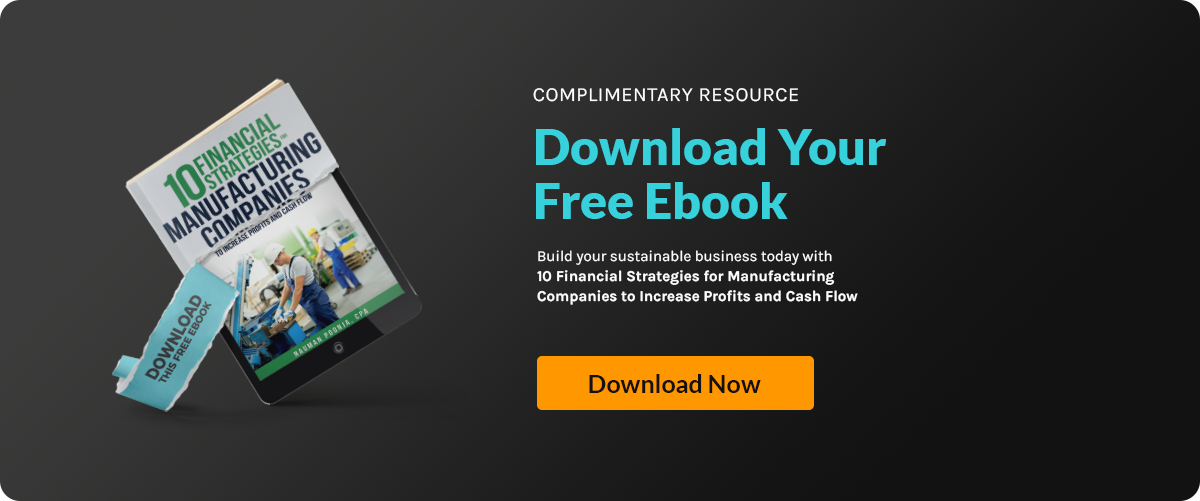Cost-Volume-Profit (CVP) analysis is a powerful tool for manufacturing businesses. It offers...
Cost Volume Profit Analysis in Manufacturing Businesses

Correctly managing sales volume and costs can significantly boost profits. In one case, total expenses for a manufacturing company accounted for 92% of its total revenue, demonstrating the need for careful cost management. Understanding how costs, sales volume, and profits interact is crucial in the competitive manufacturing industry.
Are you curious about how CVP analysis can benefit your manufacturing profits? Continue reading to discover the transformative potential of this analysis for your business.
What is a Cost Volume Profit Analysis?
A Cost-Volume-Profit analysis is used to understand the relationship between a business's cost, volume, and profit. It helps in evaluating how changes in costs and sales volume affect profitability. The analysis focuses on the contribution margin and the difference between sales and variable costs per unit. By identifying the break-even point, CVP analysis helps businesses make informed decisions about production levels and pricing strategies.
What is a CVP Graph and How Do You Plot One?
A Cost-Volume-Profit (CVP) graph is a powerful visualization tool that helps business owners and managers quickly grasp how sales, costs, and profit interact at different production levels. Rather than sifting through endless numbers, the CVP graph paints a picture—literally—of how changes in volume can affect profitability.
Plotting a CVP Graph:
- X-axis: Represents the level of activity, typically the number of units produced or sold.
- Y-axis: Shows the dollar amounts for both sales and total costs.
To create the graph:
- Plot the Fixed Costs: Start with a horizontal line parallel to the X-axis. This line doesn’t budge, no matter how many units you make—fixed costs stay the same.
- Add the Total Costs Line: Begin where the fixed costs line starts and slope it upward. As you increase production, variable costs are added to fixed costs, so this line rises with each additional unit.
- Draw the Total Sales Line: Start at the origin (where both axes meet) and draw a line that rises with each unit sold. This line represents your revenue from selling products.
- Identify the Break-Even Point: The magic happens where the total sales line crosses the total costs line. This is your break-even point—the number of units you need to sell for your revenue to equal your total expenses.
With this graph, you can experiment visually: see how changes in fixed costs, variable costs, or selling price alter your break-even point. For example, if your break-even lands between 2,000 and 3,000 units, you know exactly where profitability begins and can plan accordingly.
A CVP graph is more than just lines and numbers—it’s a roadmap, making it easier to set production targets and pricing strategies that support growth and long-term success.
Understanding Cost-Volume-Profit Ratio
Business owners know the importance of managing every aspect of their operations to ensure success. One key area is understanding the financial dynamics that drive profitability. This is where the CVP analysis comes into play. This analysis helps businesses determine the relationship between cost, sales volume, and profit, providing insights for making informed decisions. Here's what you need to know about this strategy:
Visualizing Profitability with a CVP Graph
A Cost-Volume-Profit (CVP) graph offers a straightforward visual snapshot of how costs, sales, and profits interact as production or sales volume changes. Think of it as a roadmap for financial decision-making.
On a typical CVP graph, the horizontal axis (X-axis) reflects the level of activity, such as units sold, while the vertical axis (Y-axis) displays dollars, representing total costs and total sales. As you plot these lines, an important intersection emerges: the point where total sales revenue matches total costs. This is known as the break-even point—the threshold where your business covers all expenses, but hasn’t yet turned a profit.
- Below this point: The company is operating at a loss.
- Above this point: Every additional sale contributes to profit.
This visual tool highlights how shifts in selling price, production costs, or sales volume would affect profitability. Business leaders can quickly assess scenarios—such as raising prices or reducing costs—and see how those changes shift the break-even point and impact the overall margin of safety. In uncertain times, it’s a handy way to understand the risks associated with declining sales or narrowing profit margins.
By relying on the clarity of a CVP graph, stakeholders gain confidence in planning, pricing, and production decisions, setting the stage for better financial outcomes.
Components of CVP Analysis
The components of CVP analysis include the contribution margin, fixed costs, and variable costs. The contribution margin is the difference between the selling price per unit and the variable cost per unit. Fixed costs remain constant regardless of production or sales levels, while variable costs change with the activity level.
To illustrate, imagine you own a sandwich shop. The variable cost is the cost of making each sandwich—think bread, mustard, pickles, and any other ingredients. This cost is called "variable" because it rises and falls with the number of sandwiches you make. For example, if the cost of producing one sandwich is $3, then making ten sandwiches would cost $30 in variable expenses. If you didn't make any sandwiches, you'd have no variable costs at all.
Here are the key components:
- The contribution margin is the difference between the selling price per unit and the variable cost per unit.
- Fixed costs remain constant regardless of the level of production or sales.
- Variable costs change with the level of activity or production.
- Total sales are needed to cover fixed and variable costs.
- Operating income derived from sales after covering all costs.
By breaking down costs into fixed and variable elements, CVP analysis equips business owners with a clear snapshot of what it truly costs to produce and sell their products. This clarity is critical for pinpointing how many units need to be sold to cover expenses—and ultimately, to turn a profit.
Determining the Break-Even Point
The break-even point is the sales volume needed to cover all fixed and variable costs, resulting in no profit or loss. This analysis is essential for understanding the minimum performance required to avoid losses. Businesses can set realistic sales targets and pricing strategies by determining the break-even point.
To determine the break-even point:
- Calculate the sales volume needed to cover fixed costs.
- Understand that at the break-even point, there is no profit or loss.
- Assume all costs can be classified as either fixed or variable.
Calculating Break-Even in Sales Dollars
While break-even analysis is commonly performed in terms of units sold, many businesses need to know the sales dollar amount required to break even. To do this, divide the total fixed costs by the contribution margin ratio (the percentage of each sales dollar that contributes to covering fixed costs after variable costs are paid).
Formula:
Break-Even Sales ($) = Fixed Costs / Contribution Margin Ratio
Example:
Suppose your business has fixed costs of $20,000 and a contribution margin ratio of 40% (or 0.4). The break-even sales in dollars would be:
$20,000 ÷ 0.4 = $50,000
In this scenario, reaching $50,000 in sales means you have covered both your fixed and variable costs, and any sales beyond this point contribute directly to profit.
By identifying your break-even point in both units and sales dollars, you gain a clearer understanding of the targets you need to hit to ensure your business remains profitable.
Margin of Safety in CVP Analysis
The margin of safety is an important measure in CVP analysis. It shows how much sales can drop before a business reaches its break-even point. In other words, it highlights the difference between actual sales and break-even sales.
A higher margin of safety means the business has a cushion—sales can fall without immediately leading to losses. On the other hand, a low margin of safety signals higher risk; even a small decline in sales volume could result in operating losses.
Knowing your margin of safety helps management assess risk levels and make decisions to protect profitability during economic downturns or periods of uncertainty. This allows for better planning and more confident goal-setting.
Target Profit Calculation
CVP analysis can also help calculate the sales needed to achieve a target profit. By knowing the desired operating income, businesses can determine the required level of sales. This helps set realistic sales goals and pricing strategies to meet financial objectives.
To calculate target profit:
- Determine the required level of sales to reach the desired operating income.
- Use the CVP ratio to assess how changes in sales affect profit margins.
Sensitivity Analysis
Sensitivity analysis evaluates how changes in sales volume, costs, and prices impact profitability. This analysis helps businesses prepare for different scenarios and make strategic decisions. By understanding potential fluctuations, companies can better manage risks and opportunities.
Steps for sensitivity analysis:
- Assess how cost fluctuations impact profitability.
- Evaluate how changes in sales volume, costs, and prices affect operating income.
- Prepare for different scenarios and make strategic decisions.
Making Business Decisions
Businesses can use CVP analysis to make informed pricing, production levels, and cost control decisions. This analysis helps plan and forecast future financial performance, ensuring companies are better prepared to navigate market changes.
Ways to use CVP analysis for decision-making:
- Make informed business decisions about pricing, production levels, and cost control.
- Plan and forecast future financial performance.
- Understand the impact of changes in sales and production on profitability.
Limitations and Challenges of CVP Analysis
While CVP analysis is a valuable tool for decision-making, it does have some important limitations businesses should consider.
- Classification Difficulties: Distinguishing between fixed and variable costs can be more complicated than it appears. Certain expenses—like lease payments, utilities, or contractual obligations—may behave unpredictably over time, making precise classification a challenge.
- Changing Cost Structures: Fixed costs are not always truly “fixed.” Contracts might be renegotiated, rents can fluctuate, and government taxes or fees could change without warning. As a result, assumptions made in a CVP analysis may not hold indefinitely.
- Treatment of Mixed Costs: Some costs have both fixed and variable components (often called semi-variable or mixed costs), and these can be tricky to allocate accurately. Incorrect assumptions about these can lead to misleading results.
- Simplifying Assumptions: CVP analysis assumes a linear relationship between cost, volume, and profit, and that sales mix or production efficiencies stay constant. In reality, markets, demand, and operational factors often fluctuate, reducing the accuracy of predictions over longer periods.
Given these constraints, CVP analysis works best as a guide for decision-making rather than an exact science. Regularly updating your financial models and incorporating the most current data available will help you make the most effective use of this tool.
Real-World Risks of Skipping CVP Analysis
Overlooking CVP analysis can lead to some costly missteps—sometimes quite literally. For example, a business might offer a product that seems popular but doesn’t generate enough revenue to cover its costs. If you’re not regularly crunching the numbers, it’s easy to end up in a scenario where each sale quietly chips away at profitability rather than building it.
- Hidden Losses: Production or sales decisions made without a clear understanding of cost behavior can result in selling products at a loss, often masked by seemingly healthy order volumes.
- Resource Drain: Allocating time, effort, and capital to low-margin products or services may drain resources from more profitable areas—without anyone realizing until it’s too late.
- Missed Red Flags: Without routine CVP analysis, it’s easy to overlook when costs creep up, prices slip, or volumes drop—any of which can erode profits unnoticed.
- Inability to Pivot in Crises: As seen during events like the COVID-19 pandemic, industries including hospitality and retail learned that real-time CVP analysis was crucial for survival. When market conditions shift unexpectedly, businesses able to quickly assess their cost and volume structure are better positioned to pivot and avoid unnecessary losses.
The bottom line: skipping CVP analysis means flying blind when it comes to operational performance. It increases the risk of making decisions based on gut feeling rather than solid data, leading to avoidable setbacks—or worse, jeopardizing the business altogether.
Cost Forecasting in Manufacturing
Cost forecasting is essential for manufacturing businesses to plan and allocate resources effectively. It involves predicting future expenses and revenues to make informed decisions that enhance profitability.
Here’s a guide on what manufacturing businesses should do for accurate cost forecasting and the expected results.
What You Should Do: Analyze Historical Data
Review past financial records to identify trends and patterns in expenses and revenues. Understanding historical data helps in accurately predicting future financial performance.
Expected Result:
Businesses can more accurately predict future costs and revenues by analyzing historical data. This leads to better budgeting and resource allocation, optimizing financial performance.
What You Should Do: Monitor Market Conditions
Monitor market conditions that affect your industry. This includes tracking raw material prices, labor costs, and demand fluctuations.
Expected Result:
Monitoring market conditions helps businesses adjust their forecasts based on real-time data. This ensures that the predictions remain relevant and accurate, aiding in effective decision-making.
What You Should Do: Use Cost Forecasting Tools
Implement advanced forecasting tools and software to analyze data and generate accurate forecasts. These tools can handle complex calculations and provide detailed insights.
Expected Result:
Using forecasting tools enhances prediction reliability. Businesses can make informed decisions more confidently, improving financial stability and growth.
What You Should Do: Include Variable and Fixed Costs
Account for both variable and fixed costs in your forecasts. Understanding how these costs behave at different activity levels is crucial for accurate predictions.
Expected Result:
Including variable and fixed costs in forecasts helps understand the total cost structure. This enables businesses to optimize pricing strategies and manage expenses effectively.
What You Should Do: Conduct Sensitivity Analysis
Perform sensitivity analysis to evaluate how changes in key assumptions affect forecasts. This involves testing different scenarios to understand potential risks and opportunities.
Expected Result:
Conducting sensitivity analysis allows businesses to prepare for various outcomes. This helps mitigate risks and capitalize on opportunities, ensuring better financial performance.
How Regular Updates on Cost Data Impact CVP Analysis
Regularly updating cost data is a fundamental practice that can significantly enhance the accuracy and effectiveness of Cost-Volume-Profit (CVP) analysis. Here's how:
- Reflecting Real-Time Market Conditions: By keeping cost data current, businesses ensure that their CVP analysis reflects the most recent market dynamics. This allows for more reliable predictions about how changes in costs, sales volume, or pricing might impact profits.
- Improving Decision-Making: Up-to-date cost information enables businesses to make informed decisions swiftly. With accurate data at hand, firms can better assess the financial implications of strategic moves, such as launching a new product or entering a new market.
- Enhancing Financial Accuracy: Regular updates minimize the risk of using outdated figures, which could lead to erroneous conclusions and potentially costly miscalculations in financial forecasting and budgeting.
- Adapting to Cost Variability: Costs can fluctuate due to various factors like supply chain issues or changes in supplier pricing. By routinely updating data, businesses can adapt their CVP analysis to reflect these variations, maintaining relevance and reliability.
- Supporting Competitive Strategy: An agile approach to cost data update ensures that business strategies remain competitive. Companies can swiftly adjust prices, optimize production, or reallocate resources to align with current financial realities and market opportunities.
By making regular cost data updates a priority, businesses fortify their CVP analysis's precision and relevance, fostering an environment where strategic decisions are grounded in the most accurate financial picture.
Conducting Profitability Analysis
An explicit guide can make conducting a profitability analysis much easier and more effective. This process helps businesses evaluate their financial performance and make informed decisions. Here’s a simple step-by-step guide to help you get started.
Step 1: Gather Financial Data
Collect all relevant financial data, including sales revenue, expenses, and production volume. This data forms the basis for your profitability analysis.
Step 2: Calculate Contribution Margin
Determine the contribution margin by subtracting variable costs from sales revenue. This margin helps businesses understand how much their revenue contributes to covering fixed costs and generating profit.
Step 3: Determine Fixed Costs
Identify and sum all fixed costs associated with running your business. Fixed costs remain constant regardless of production volume, so understanding them is crucial for accurate analysis.
Step 4: Analyze Sales Revenue and Production Volume
Evaluate how changes in sales revenue and production volume impact your profitability. This step helps businesses understand how different activity levels affect their financial performance.
Step 5: Use Cost-Volume-Profit Ratio
Use this ratio to assess the relationship between costs, sales volume, and profit. It is a powerful tool for businesses to evaluate their financial health and make strategic decisions.
Enhancing CVP Analysis through Technology in FP&A
Cost-Volume-Profit (CVP) analysis is an essential tool for businesses seeking to strengthen their long-term financial strategy. By evaluating how variations in sales volume, costs, and pricing impact profitability, companies gain insights critical for strategic planning.
Strategic Insights Through CVP
- Flexibility in Scenario Planning: CVP analysis enables firms to simulate various business conditions—best-case, worst-case, and most likely scenarios—by adjusting variables like market entry points or fluctuating costs. This simulation provides a robust framework for predicting future outcomes.
- Informed Decision-Making: By understanding potential changes in the financial landscape, businesses can make informed decisions regarding expansions and other strategic goals. CVP provides clarity on how immediate decisions might influence future profitability.
- Identifying Breakeven Points: Modeling different market conditions helps businesses pinpoint breakeven points, aiding in evaluating the feasibility of long-term projects, such as market expansion.
Visualizing Impact for Growth
- Comprehensive Projections: CVP analysis delivers a detailed picture of future financial performance, offering a roadmap for growth and expansion.
- Adapting to Change: By projecting financial changes over time, businesses can adapt strategies efficiently, ensuring sustained profitability even in fluctuating market conditions.
In essence, integrating CVP analysis into financial planning equips businesses to tackle uncertainties with confidence, making it an indispensable element of successful long-term financial forecasting.
Maximize Your Profits with Accounovation's CVP Analysis
Accounovation empowers your business with precise, data-driven insights through our controller services. Our team streamlines your financial systems, allowing you to focus on strategic decisions and growth. With our expertise, you can better understand costs, sales volume, and profits to make informed choices.
Schedule a consultation with Accounovation today and unlock the full potential of CVP Analysis for your manufacturing business.
Frequently Asked Questions
Why is engaging cross-functional teams important in cost analysis?
Engaging cross-functional teams in cost analysis is important because it brings diverse perspectives, ensures comprehensive evaluation, and identifies hidden costs across departments. Collaboration helps align goals, improves decision-making, and ensures cost-saving strategies are practical and effective across the organization.
What is the significance of using conservative estimates for uncertainties in CVP analysis?
Using conservative estimates in CVP analysis accounts for risks, ensures realistic projections, and safeguards financial stability by minimizing overestimation of profits or underestimation of costs.
How can CVP analysis be applied to multi-product decision-making?
CVP analysis aids multi-product decisions by using a weighted average contribution margin, helping businesses determine breakeven points and optimize profitability across product lines.
Why is it important for CVP analysis to align with strategic business objectives?
Aligning CVP analysis with strategic business objectives ensures financial decisions support long-term goals, optimize resource allocation, and drive profitability while maintaining focus on the organization's overall mission and priorities.







